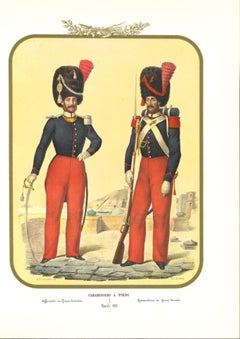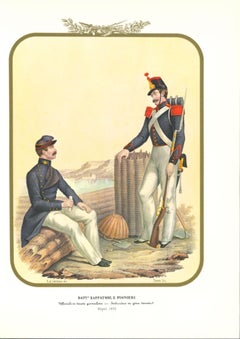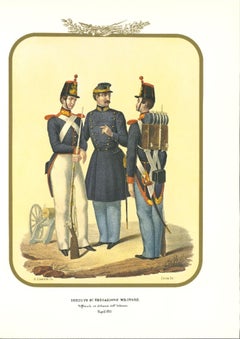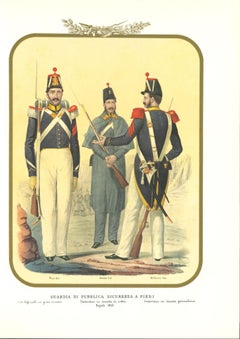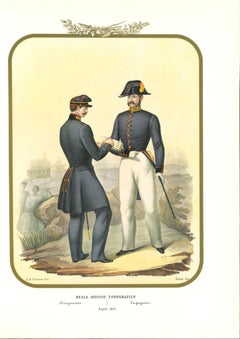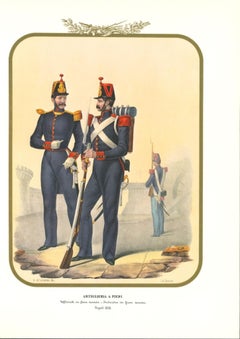1850s Art
to
184
1,009
100
40
27
25
Overall Width
to
Overall Height
to
7,504
21,240
158,654
233,774
1,954
2,274
4,863
6,406
5,796
13,171
19,497
25,561
18,190
13,732
5,363
830
15
8
4
2
2
1
670
499
21
652
369
307
264
225
177
146
108
83
76
69
69
66
55
48
45
45
45
38
36
842
321
161
117
65
119
87
58
58
16
161
658
380
171
Period: 1850s
Carabinieri - Original Lithograph by Antonio Zezon - 1853
Located in Roma, IT
Carabinieri is an original lithograph by Antonio Zezon. Naples 1853.
Interesting colored lithograph which describes some members of the "Carabinieri a piedi": Official in dress unif...
Category
Modern 1850s Art
Materials
Lithograph
Battalion Zappatori and Pioneri - Original Lithograph by Antonio Zezon - 1853
Located in Roma, IT
Battalion Zappatori and Pioneri is an original lithograph by Antonio Zezon. Naples 1853.
Interesting colored lithograph which describes some members of the Battalion Zappotori and P...
Category
Modern 1850s Art
Materials
Lithograph
Military Education Institute - Original Lithograph by Antonio Zezon - 1853
Located in Roma, IT
Military Education Institute is a original lithograph by Antonio Zezon. Naples 1853.
Interesting colored lithograph which describes some members of the Military Education Institute:...
Category
Modern 1850s Art
Materials
Lithograph
Public Security Guard - Lithograph by Antonio Zezon - 1852
Located in Roma, IT
Public Security Guard is a lithograph by Antonio Zezon. Naples 1852.
Interesting colored lithograph which describes some members of the Public Security...
Category
Modern 1850s Art
Materials
Lithograph
Royal Topographical Office - Lithograph by Antonio Zezon - 1855
Located in Roma, IT
Royal Topographical Office is a lithograph by Antonio Zezon. Naples 1855.
Interesting colored lithograph which describes some members of the Royal Topographical Office: Draftsman - ...
Category
Modern 1850s Art
Materials
Lithograph
Artillery - Lithograph by Antonio Zezon - 1853
Located in Roma, IT
Artillery is a lithograph by Antonio Zezon. Naples 1853.
Interesting colored lithograph which describes some members of the Artillery: Official in dress uniform - Individual in dre...
Category
Modern 1850s Art
Materials
Lithograph
Swiss Artillery - Lithograph by Antonio Zezon - 1854
Located in Roma, IT
Swiss Artillery is a lithograph by Antonio Zezon. Naples 1854.
Interesting colored lithograph which describes some members of the Swiss Artillery: Individual in great dress - Offici...
Category
Modern 1850s Art
Materials
Lithograph
Administrative Body of the Real Marin - Original Lithograph by A. Zezon - 1855
Located in Roma, IT
Administrative Body of the Real Marina is a lithograph by Antonio Zezon. Naples 1855.
Interesting colored lithograph which describes the administrative body of the Real Marina: on t...
Category
Modern 1850s Art
Materials
Lithograph
Ex Libris Jarmay Zoltan - Woodcut - Early 20th Century
Located in Roma, IT
Ex Libris Jarmay Zoltan is an original Contemporary Artwork realized in the 19th Century.
Original Ex Libris.
Original B/W woodcut print on ivory-colored paper. Titled on the centr...
Category
Modern 1850s Art
Materials
Woodcut
'Kettle Falls, Columbia River' original color lithograph by John Mix Stanley
Located in Milwaukee, WI
In the mid-nineteenth century, the United States government set out to survey and document its newly acquired lands and territories west of the Mississippi. The goals of these surveys were manifold: to produce topographical maps, to document flora and fauna, and to document natural resources to build the emerging US economy. These surveys, and the images from them, also functioned to build the new sense of American identity with the landscape, condensing vistas into the 'picturesque' tradition of European image making. Thus, the entire span of US territory could be seen as a single, cohesive whole.
This lithograph comes from one of six surveys commissioned by the Army's Topographic Bureau in 1853, which sought to find the best route to construct a transcontinental railroad. The result was a thirteen-volume report including maps, lithographs, and technical data entitled 'Explorations and Surveys to ascertain the most practicable and economical route for a Railroad from the Mississippi river to the Pacific Ocean.'
When it came to depicting the Columbia River, as seen in the present print, Stanley chose to depict the river's characteristic rock formations and choppy waters. The figures in the image give the viewer a sense of the vase scale of the imposing landscape. Other explorers that reached the site years before the Pacific Railroad Survey, such as Lewis and Clark, observed this scene with wonder and awe – and it is clear Stanley felt the same way.
5.75 x 8.75 inches, image
6.5 x 9.25 inches, stone
13.25 x 16.25 inches, frame
Artist 'Stanley Del.' lower left
Entitled 'Kettle Falls, Columbia River' lower center margin
Publisher 'Sarony, Major & Knapp. Lith.s 449 Broadway N.Y.' lower right
Inscribed 'U.S.P.R.R. EXP. & SURVEYS — 47th & 49th PARALLELS' upper left
Inscribed 'GENERAL REPORT — PLATE XLVII' upper right
Framed to conservation standards using 100 percent rag matting and Museum Glass to inhibit fading; housed in a brass-surface aluminium moulding.
Print in overall good condition; wrinkles in upper margin and upper right corner; frame in excellent condition.
John Mix Stanley...
Category
Romantic 1850s Art
Materials
Lithograph
The Fairy Library - Rare Book Illustrated by George Cruikshank - 1850
Located in Roma, IT
The Fairy Library is a set of original modern rare books written by various authors and illustrated by George Cruikshank (London, 1792 - London, 1878) between 1853-1854.
Published by David Bogue, London.
Original First Edition.
Format: in 8°.
The book includes Four Volumes (they includes 30, 32, 31 and 40 pages with illustrated wrappers and 24 full page Etchings; there is also an extra suite of Twentyfour hand colored etchings).
Mint conditions.
George Cruikshank (London, 1792 - London, 1878) was a British caricaturist and book illustrator, praised as the "modern Hogarth" during his life. His book illustrations for his friend di lui Charles Dickens, and many other authors, reached an international audience. For Charles Dickens, Cruikshank illustrated Sketches by Boz...
Category
Modern 1850s Art
Materials
Paper, Etching
Glorious Return of the Holy Father in Rome - Etching after B. Pinelli - 1850
Located in Roma, IT
Glorious Return of the Holy Father in Rome is an original Hand-colored etching artwork realized by Italian artist Bartolomeo Pinelli in 1850.
With the description of artwork on the ...
Category
Modern 1850s Art
Materials
Etching
'Distribution of Goods to the Gros Ventres' lithograph by John Mix Stanley
Located in Milwaukee, WI
In the mid-nineteenth century, the United States government set out to survey and document its newly acquired lands and territories west of the Mississippi. The goals of these surveys were manifold: to produce topographical maps, to document flora and fauna, and to document natural resources to build the emerging US economy. These surveys, and the images from them, also functioned to build the new sense of American identity with the landscape, condensing vistas into the 'picturesque' tradition of European image making. Thus, the entire span of US territory could be seen as a single, cohesive whole.
This lithograph comes from one of six surveys commissioned by the Army's Topographic Bureau in 1853, which sought to find the best route to construct a transcontinental railroad. The result was a thirteen-volume report including maps, lithographs, and technical data entitled 'Explorations and Surveys to ascertain the most practicable and economical route for a Railroad from the Mississippi river to the Pacific Ocean.' In particular, the print comes from the northern survey, commanded by Isaac Stevens, which explored the regions between the 47th and 49th parallels.
In this image, Stanley documented the encounter with the Gros Ventre people at Milk River. The explorers were invited to the Gros Ventres camp and the two groups exchanged gifts in friendship. The Stevens Party provided "... blankets, shirts, calico, knives, beads, paint, powder, shot, tobacco, hard bread, etc." The image likewise alludes to how, in 1855, Isaac Stevens, concluded a treaty (Stat., L., XI, 657) to provide peace between the United States and the Blackfoot, Flathead and Nez Perce tribes. The Gros Ventres signed the treaty as part of the Blackfoot Confederacy, whose territory near the Three Fork area became a common hunting ground for the Flathead, Nez Perce, Kootenai, and Crow Indians.
5.75 x 8.75 inches, image
6.5 x 9.25 inches, stone
17 x 20 inches, frame
Artist 'Stanley Del.' lower left
Entitled 'Distribution of Goods to the Gros Ventres' lower center margin
Publisher 'Sarony, Major & Knapp. Lith.s 449 Broadway N.Y.' lower right
Inscribed 'U.S.P.R.R. EXP. & SURVEYS — 47th & 49th PARALLELS' upper left
Inscribed 'GENERAL REPORT — PLATE XXI' upper right
Framed to conservation standards using 100 percent rag matting with French accents; glazed with UV5 Plexiglas to inhibit fading; housed in a gold reverse ogee moulding.
Print in overall good condition; some localized foxing and discoloration; minor surface abrasions to frame.
John Mix...
Category
Romantic 1850s Art
Materials
Lithograph
Arab Man - Original Lithograph by Lacoste Jean Luis - 1854
Located in Roma, IT
Arabic is an original modern artwork realized in 1854 by Lacoste Jean Luis.
Original Hand-colored lithograph on paper.
Plate signed on the lower, titled lowe...
Category
Modern 1850s Art
Materials
Lithograph
Les Garçons en Habit Noir - Lithograph by H. Daumier - 1850s
Located in Roma, IT
Les Garçons en Habit Noir is a b/w lithographed plate, from the series containing a total of 120 prints, Croquis Parisiens. Realized by Honoré Daumier (Franc...
Category
1850s Art
Materials
Lithograph
Parisiens Recevant un Grain - Lithograph by H. Daumier - 1852
Located in Roma, IT
Parisiens recevant un grain (…) (Parisians experiencing a squall) is a b/w lithograph (plate n.12) from the satirical print series “Les Trains de Plaisir”, composed of caricatures “...
Category
1850s Art
Materials
Lithograph
Parisiens Surpris par la Marée - Lithograph by H. Daumier - 1852
Located in Roma, IT
Parisiens surpris par la marée (…) is a b/w lithograph (plate n.13) from the satirical series “Les Trains de Plaisir”, composed of caricatures “de mœurs” (of behaviours), realized by...
Category
1850s Art
Materials
Lithograph
The Gymnaste - Original Pencil on Paper - 1850s
Located in Roma, IT
The Gymnaste is an original modern artwork realized in the 19th Century in France.
Original pencil on paper.
Very good condition.
The Gymnaste is an excellent artwork on paper tha...
Category
1850s Art
Materials
Pencil
Characters - Original China Ink on Paper - Mid-19th Century
Located in Roma, IT
Characters is an modern artwork realized inmid-20th Century in France.
Original china ink on paper.
On the back of the work there is a second drawing.
Very good conditions.
Characters is an excellent modern artwork realized in France in the half of the XIX Century and it shows us several characters in a high room. On the background there is a window with an iron grate. The work depicts also a nude figure on the back of the sheet. The second drawing is realized in pencil and shows us a female reclining nude.
Category
Modern 1850s Art
Materials
Paper, Ink
Persian Woman - Original Lithograph - 1851 ca
Located in Roma, IT
Persian Woman is an original hand-watercolored lithograph on ivory paper by Anonymous Italian Artist in 1851s.
In excellent conditions.
Not signed. Titled on the lower center.
Category
Modern 1850s Art
Materials
Lithograph
Oriental Crying Woman - Lithograph on Paper - 1856
Located in Roma, IT
Oriental Crying Woman is a hand-colored lithograph on paper realized in 1856 ca. by an unknown artist of the XIX century.
Titled on the lower center in Italian" Una donna che piange...
Category
1850s Art
Materials
Lithograph
Meeting - Original Photogravure by Constantine Guys - 1850s
Located in Roma, IT
Meeting is a wonderful original print on brownish paper, realized by the French artist, Constantin Guys (1802 -1892).
In very good condition, including a pet...
Category
Symbolist 1850s Art
Materials
Photogravure
$207 Sale Price
30% Off
Interieur de Geneve [...] - Lithograph by Antonio Fontanesi - 1850s
Located in Roma, IT
This splendid lithograph Interieur de Geneve. Fontaine de l'Hotel De Ville is part of the series of 20 prints dedicated to views of the city of Geneva, engraved by the Italian artist...
Category
1850s Art
Materials
Lithograph
Interieur de Geneve. Place de la Grenet - Lithograph by Antonio Fontanesi - 1854
Located in Roma, IT
This splendid lithograph Interieur de Geneve. Place de la Grenette is part of the series of 20 prints dedicated to views of the city of Geneva, engraved by the Italian artist Antonio...
Category
Old Masters 1850s Art
Materials
Lithograph
Woman Figure - Pencil on Paper - 1853
By Edmound De Beaumont
Located in Roma, IT
"Woman Figure" 1853's is a drawing on paper, signed and dated by Edmond De Beaumont, on the back of the drawing.
In excellent conditions: as good as new...
Category
Modern 1850s Art
Materials
Pencil
$290 Sale Price
30% Off
Portrait - Original Drawing In Pen - 1850s
Located in Roma, IT
Portrait 1850's is an original drawing in pen on paper, realized by an unwkown artist named Bruant (XIX-XX).
Sheet dimension: 29.4 x 22 cm.
The artwork represents beautiful quick ...
Category
Modern 1850s Art
Materials
Pen
$463 Sale Price
35% Off
Women - Woodcut Print - 1850s
Located in Roma, IT
Women is a beautiful woodcut print realized by Frédéric Florian in the mid-19th century.
In very good condition.
Hand signed on the right lower margin,...
Category
Modern 1850s Art
Materials
Woodcut
Gene - Original Lithograph - 1950 ca.
Located in Roma, IT
Gene is a beautiful original lithograph realized by Eugène Flandin (1809-1889) in 1850 ca.
Signed on the plate by the artist on the lower left margin, lithographed by Jules Collign...
Category
1850s Art
Materials
Lithograph
View of Geneve - Lithograph by Antonio Fontanesi - 1850 ca.
Located in Roma, IT
Image dimensions: M-109655 cm.
This splendid lithograph View of Geneve is part of the series of prints dedicated to views of the city of Geneva, engraved by the Italian artist Antonio Fontanesi.
The state of preservation of the artwork is excellent.
The signature is engraved on the plate the lower left. At the top of the paper, the inscription “Interieur de Geneve”, while at the bottom, below the image, the inscription “JMP Pilet & Cougnard Editeurs Geneve”.
Antonio Fontanesi (Reggio Emilia, 1818 - Turin, 1882) was an Italian painter, engraver, teacher, and soldier. He was one of the most important 19th-century Italian painters, though somewhat unknown. After fighting in the I Independence War...
Category
1850s Art
Materials
Lithograph
$498 Sale Price
30% Off
Roman Statue - Etching On Paper - 1850
Located in Roma, IT
Roman Statue is an original etching on paper realized by an Anonymous artist of the XIX century in 1850 ca.
In very good condition.
Included a white...
Category
1850s Art
Materials
Etching
$166 Sale Price
30% Off
Geneva, Rue De L'Hôtel De Ville - Lithograph by A. Fontanesi - 1854
Located in Roma, IT
Image dimensions: 20.5 x 15 cm.
This splendid lithograph Interieur de Geneve. Rue De L'Hôtel De Ville is part of the series of 20 prints dedicated to views of the city of Geneva, en...
Category
Naturalistic 1850s Art
Materials
Lithograph
Geneva, Cour Du Collège - Lithograph by A. Fontanesi - 1854
Located in Roma, IT
This splendid lithograph Interieur de Geneve. Cour Du Collège is part of the series of 20 prints dedicated to views of the city of Geneva, engraved by the Italian artist Antonio Font...
Category
Naturalistic 1850s Art
Materials
Lithograph
Artilleurs - Lithograph by D.A.M. Raffet - 1858
Located in Roma, IT
Signed on plate, “Raffet San Donato Février 1858”. Title “Artilleurs allant prendre service des Batteries n. 1 e n.2, Siège de Rome, 5 juin 1849” was printed at the centre. “Paris,G...
Category
1850s Art
Materials
Lithograph
'Lieutenant Crovers Despatch – Return of Governor Stevens to Fort Benton'
Located in Milwaukee, WI
In the mid-nineteenth century, the United States government set out to survey and document its newly acquired lands and territories west of the Mississippi. The goals of these surveys were manifold: to produce topographical maps, to document flora and fauna, and to document natural resources to build the emerging US economy. These surveys, and the images from them, also functioned to build the new sense of American identity with the landscape, condensing vistas into the 'picturesque' tradition of European image making. Thus, the entire span of US territory could be seen as a single, cohesive whole.
This lithograph comes from one of six surveys commissioned by the Army's Topographic Bureau in 1853, which sought to find the best route to construct a transcontinental railroad. The result was a thirteen-volume report including maps, lithographs, and technical data entitled 'Explorations and Surveys to ascertain the most practicable and economical route for a Railroad from the Mississippi river to the Pacific Ocean.' In particular, the print comes from the northern survey, commanded by Isaac Stevens, which explored the regions between the 47th and 49th parallels.
5.75 x 8.75 inches, image
6.5 x 9.25 inches, stone
17 x 20 inches, frame
Artist 'Stanley Del.' lower left
Entitled 'Lieutenant Crovers Despatch – Return of Governor Stevens to Fort Benton' lower center margin
Publisher 'Sarony, Major & Knapp. Lith.s 449 Broadway N.Y.' lower right
Inscribed 'U.S.P.R.R. EXP. & SURVEYS — 47th & 49th PARALLELS' upper left
Inscribed 'GENERAL REPORT — PLATE XXXVII' upper right
Framed to conservation standards using 100 percent rag matting with French accents; glazed with UV5 Plexiglas to inhibit fading; housed in a gold reverse ogee moulding.
Print in overall good condition; some localized foxing and discoloration; minor surface abrasions to frame.
John Mix Stanley...
Category
Romantic 1850s Art
Materials
Lithograph
Interieur de Geneve. Porte Neuve - Lithograph by A. Fontanesi
Located in Roma, IT
Image dimensions: 15 x 22 cm.
This splendid lithograph Interieur de Geneve. Porte Neuve is part of the series of 20 prints dedicated to views of the city of Geneva, engraved by the ...
Category
1850s Art
Materials
Lithograph
Une Queue - Lithograph by Henry Monnier - 1850s
Located in Roma, IT
Une Queue is an amusing watercolored original lithograph realized by Henry Monnier (1805 - 1877).
This original print represents people in line to buy ...
Category
Modern 1850s Art
Materials
Lithograph
19th Century Oil on Canvas American Signed and Dated Painting Landscape, 1854
Located in Vicoforte, IT
Antique American painting from the mid 19th century. Framework oil on canvas, on the first canvas, depicting a countryside landscape with a co...
Category
1850s Art
Materials
Canvas, Oil
Women portraits from Napoleon III period
Located in BELEYMAS, FR
Charles CHAPLIN
(Les Andelys 1825 – Paris, 1891)
Portraits of women
Pair of oils on rectangular canvases
H. 60 cm; L. 50 cm
Signed
Student of Michel Martin Drolling at the École des...
Category
French School 1850s Art
Materials
Canvas, Oil
Bordeaux - Cathedral From The River
Located in Carmel-by-the-Sea, CA
Albumen print by Charles Marville circa 1856. Blind Stamp on mount recto.
Category
1850s Art
Materials
Photographic Paper
"Violette" Oil on Canvas
Located in Los Angeles, CA
A beautifully painted oil on canvas of a flower vendor. Signed illegibly upper right corner. Framed in an ornate ebonized and gilded frame.
Category
Other Art Style 1850s Art
Materials
Canvas, Paint
19th century watercolor of a street scene in Tewkesbury, England
Located in Los Angeles, CA
Framed in wood with museum glass to 9" x 11"
One of the watercolors says
Tweksbury, July (?) 1850
Framed by Commonwealth Print Conservation, Boston in 1988
Very nice watercolor. Par...
Category
1850s Art
Materials
Watercolor
Nineteenth century silhouette of a gentleman: Lennox
Located in London, GB
To see more, scroll down to "More from this Seller" and below it click on "See all from this Seller."
Silhouette (circa 1870)
Lennox
Gouache, pen, and ink
52 x 44 cm
Prior to phot...
Category
1850s Art
Materials
Ink, Gouache, Pen
Nineteenth century silhouette of a lady: Miss Chapman
Located in London, GB
To see more, scroll down to "More from this Seller" and below it click on "See all from this Seller."
Silhouette (circa 1870)
Miss Chapman
Gouache, pen, and ink
52 x 44 cm
One of ...
Category
1850s Art
Materials
Ink, Gouache, Pen
Nineteenth-century silhouette of a lady: the Hon Mrs F Byron
Located in London, GB
To see more, scroll down to "More from this Seller" and below it click on "See all from this Seller."
Silhouette (circa 1870)
The Hon Mrs F Byron
Gouache, pen, and ink
52 x 44 cm
...
Category
1850s Art
Materials
Ink, Gouache, Pen
Watercolour Estuary Landscape Victorian
Located in Eversholt, Bedfordshire
just purchased more information to follow
Cypher lower right
Within a grey mount, 14cm high, 28cm long
The gilded cavetto moulded frame 28 cm high, 41 cm long, 3.5cm deep
Category
Victorian 1850s Art
Materials
Watercolor
Superb Neoclassical White Marble Bust of Flora France 1850 '
Located in Rome, IT
Superbly carved white statuary Carrara marble bust of Flora, the goddess of flowers.
Flora was often associated with the coming of spring and th...
Category
1850s Art
Materials
Marble
19th Century Austrian Sculpture of Fate
By Franz Melnitzky
Located in Los Angeles, CA
A signed, dated, 1855 terracotta, classical style sculpture of the robed figure of Fate holding the thread of life by listed, Austrian-born artist, Franz Melnitzky (1822-1876) whose ...
Category
1850s Art
Materials
Terracotta
Hiroshige (1797-1858) - Ueno Yamashita
Located in BRUCE, ACT
Artist: Utagawa Hiroshige (Hiroshige Ando 1797-1858)
Title: No.12 Ueno Yamashita
Series: One Hundred Famous Views of Edo (名所江戸百景)
Size: O-ban 大判
Age: 1858
Category
1850s Art
Materials
Woodcut
$3,710 Sale Price
30% Off
Worcester College Provost Richard Lynch Cotton Caricature photographic collage
Located in London, GB
To see our other works of Oxford and Cambridge , particularly suitable for wedding and graduation presents, scroll down to "More from this Seller" and below it click on "See all from this Seller" - or send us a message if you cannot find the view you want.
Provost Richard Lynch Cotton Caricature
A rare specimen of the Cotton-ia Worcester-iensis (not to be found) in the Botanic Gardens Oxford
Pen ink watercolour and photographic collage...
Category
Abstract 1850s Art
Materials
Ink, Watercolor, Pen, Photographic Paper
"Swishing A Rasper" 1850 by Henry Alken
By Henry Alken
Located in Bristol, CT
Classic fox-hunt engraving Pl.3. "Swishing a Rasper" by H(enry) Alken printed 1850 from Fores' Hunting Accomplishments in hunter green mat w/ gilt frame
Image Sz: 10"H x 12.75"W
Fr...
Category
1850s Art
Materials
Lithograph
Nasiterna Bruijni
By John Gould
Located in Missouri, MO
John Gould (British, 1804-1881)
Nasiterna Bruijni c. 1849-1861
Hand Colored Lithograph
Image Size: approx 19.5 x 13.5 inches
Framed Size: 27 3/8 x 21 1/2 inches
John Gould was an English ornithologist and bird artist. The Gould League in Australia was named after him. His identification of the birds now nicknamed "Darwin's finches" played a role in the inception of Darwin's theory of evolution by natural selection. Gould's work is referenced in Charles Darwin's book, On the Origin of Species.
Gould was born in Lyme Regis, Dorset, the son of a gardener, and the boy probably had a scanty education. Shortly afterwards his father obtained a position on an estate near Guildford, Surrey, and then in 1818 became foreman in the Royal Gardens of Windsor. He was for some time under the care of J T Aiton, of the Royal Gardens of Windsor. The young Gould started training as a gardener, being employed under his father at Windsor from 1818 to 1824, and he was subsequently a gardener at Ripley Castle in Yorkshire. He became an expert in the art of taxidermy, and in 1824 he set himself up in business in London as a taxidermist, and his skill led to him becoming the first Curator and Preserver at the museum of the Zoological Society of London in 1827.
Gould's position brought him into contact with the country's leading naturalists, and also meant that he was often the first to see new collections of birds given to the Society. In 1830 a collection of birds arrived from the Himalayas, many not previously described. Gould published these birds in A Century of Birds from the Himalaya Mountains (1830-1832). The text was by Nicholas Aylward Vigors, and the illustrations were lithographed by Gould's wife Elizabeth, daughter of Nicholas Coxen of Kent.
This work was followed by four more in the next seven years including Birds of Europe in five volumes - completed in 1837, with the text written by Gould himself, edited by his clerk Edwin Prince. Some of the illustrations were made by Edward Lear as part of his Illustrations of the Family of Psittacidae in 1832. Lear however was in financial difficulty, and he sold the entire set of lithographs to Gould. The books were published in a very large size, imperial folio, with magnificent coloured plates. Eventually 41 of these volumes were published with about 3000 plates. They appeared in parts at £3 3s. a number, subscribed for in advance, and in spite of the heavy expense of preparing the plates, Gould succeeded in making his ventures pay and in realizing a fortune. In 1838 he and his wife moved to Australia to work on the Birds of Australia and shortly after his return to England, his wife died in 1841.
When Charles Darwin presented his mammal and bird specimens collected during the second voyage of HMS Beagle to the Geological Society of London at their meeting on 4 January 1837, the bird specimens were given to Gould for identification. He set aside his paying work and at the next meeting on 10 January reported that birds from the Galápagos Islands, which Darwin had thought were blackbirds, "gross-bills" and finches were in fact "a series of ground Finches which are so peculiar" as to form "an entirely new group, containing 12 species." This story made the newspapers.
In March, Darwin met Gould again, learning that his Galápagos "wren" was another species of finch and the mockingbirds he had labeled by island were separate species rather than just varieties, with relatives on the South American mainland. Subsequently Gould advised that the smaller southern Rhea specimen that had been rescued from a Christmas dinner...
Category
Naturalistic 1850s Art
Materials
Lithograph
Watercolor featuring Castel dell'Ovo, Naples, 1851 by English Artist Howman
Located in Philadelphia, PA
Edward J. Howman
(English, nineteenth century)
Castel dell'Ovo, Naples, 1851
Watercolor and gouache on paper, 7 x 10 inches
Framed: 12 x 15 inches (approx.)
Label on backing verso: ...
Category
Realist 1850s Art
Materials
Paper, Watercolor
Touchstone and Corin, British Pre-Raphaelite 19th Century Oil on Canvas
Located in London, GB
Adolphus M. Madot
Circa 1833 - 1861
Oil on canvas
Image size: 36 x 24 inches (91.4 x 61 cm)
Arched Pre-Raphaelite style frame
The subject of the present picture is the dialogue between the court jester Touchstone and the shepherd Corin in the Forest of Arden ( As You Like It, Act III, scene 2). The work of William Shakespeare 'As You Like It' was a popular literary source in Pre-Raphaelite circles, inspiring such artists as John Everett Millais, Walter Howell Deverell and Arthur Hughes. The present picture is comparable in style to the work of Edward W. Rainford and Henry Stacy Marks...
Category
Pre-Raphaelite 1850s Art
Materials
Oil
Castle Folly 1859 Watercolour
Located in Bristol, CT
Watercolour depicting a castle tower signed & dated 1859 in a French mat & gilt frame
Art Sz: 17"H x 12 3/8"W
Frame Sz: 27 7/8"H x 23 3/8"W
Category
1850s Art
Materials
Watercolor
Oursikoff - including a copy of the Journal in which it appeared
Located in New York, NY
Honore Daumier (1808-1879), Oursikoff, lithograph, from Actualities, Plate number 72, published in Charivari, 1854. Reference: Daumier Register 2519, second state of two, a newsprint...
Category
Realist 1850s Art
Materials
Lithograph
"Getting Ready. Hearn's Hotel, Clonmel" 1856 Aquatint
Located in Bristol, CT
Car-Travelling In The South Of Ireland In The Year 1856. Bianconi's Establishment
Print Sz: 10 7/8"H x 14"W
Frame Sz: 19"H x 23"W
Published 1856 by Ackermann & Co
Engraver:
John...
Category
1850s Art
Materials
Aquatint
"Elegant Hospitality" Bar At Gentlemen's Private Club c1854 Print
Located in Bristol, CT
Print Sz: 11 1/2"H x 15"W
Frame Sz: 17 1/4"H x 20 1/2"W
Composed and drawn on stone by A. Fay
Stylish gentlemen's private club interior scene featuring a grand bar
c.1854
Category
1850s Art
Materials
Lithograph
American 1870s Hudson River Antique Gilt Painting Frame
Located in Jacksonville, FL
American 1870s Hudson River Antique Gilt Frame Antique Painting Frame
Frame Size: Width: 22″ X Height: 25″
Thickness: 3.50″
Picture Size: Wi...
Category
1850s Art
Materials
Wood
"Camanche Inscription on the Shoulder Blade of a Buffalo, " after S. Eastman
By Seth Eastman
Located in Milwaukee, WI
"Camanche Inscription on the Shoulder Blade of a Buffalo" is a lithograph after an original drawing by Seth Eastman. It depicts Native American inscriptions on an animal bone. It was...
Category
1850s Art
Materials
Lithograph
Italian Campagna
By Carl Haag
Located in London, GB
Watercolour on paper, signed and dated '1855' lower right
Image size: 20 x 14 inches (51 x 35.3 cm)
Acid free mount
This striking watercolour depicts an Italian peasant woman in the...
Category
1850s Art
Materials
Watercolor, Laid Paper
